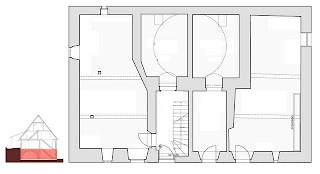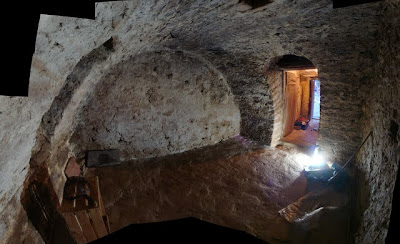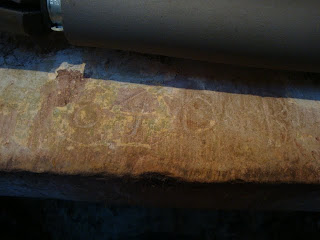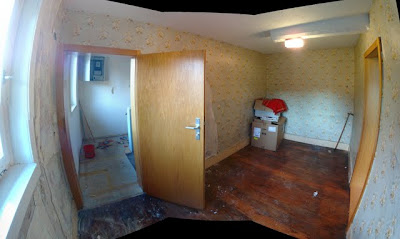 |
| Door number 1! |
The house is a so-called
Kellerhaus, or at least someone mentioned that name once, in the historical sense, meaning the entire ground level is cellar and stalls, hence the four doors on the front.
Door number 1 and door number 4, on the far left and right respectively, still have sandstone posts and lintels and lead to former animal stalls. The leftmost, cellar 1, we'll call it, is still floored with cobbles and was more recently used as an oil tank room. The cobbles are uneven, and between them is a rather unhealthy looking orange residue that reminds me of the Red Weed in War of the Worlds. A stone feeding trough is still here, in fairly good condition, but the plaster between the ceiling beams is coming out a bit. The plan for this cellar is just to use as a store room, or perhaps put the washing machine in there. For now at least.
|
| Cellar 1, behind door number 1 |
 |
| Cellar 4, behind door 4. |
The other, on the far right, behind door number 4, was more recently used as a storeroom, and some of the beams have been replaced due to the wood rotting from the dampness from the animals that were kept there in the past (cows and horses, I believe). This cellar has a general damp problem anyway, that I really only noticed this week, after all the snow melt. While the cellars are at ground level at the front of the house, they are under ground level at the back of the house, and being at the bottom of a hill, there's some water pressure coming from behind the house. In general, it's probably not bad for the house, as at least in the past the materials were breathable. However, in cellar 4 (and 3), parts of the floors have been laid over with concrete, so dampness is "exuding" in specific areas. This will have to be addressed to bring back some balance, but this room is critical, as the plan is to use this as a "technical room" for the heating equipment (probably a pellet boiler), and a store for wood pellets. This will have to be kept as dry as possible, so we'll have to think of ways to let water and moisture escape easily.
 |
| General plan of cellars, January 2011. |
Each of the centre two doors originally led into two small halls each with a staircase up to the living quarters on the first floor, as at one time the house was divided in two (we're not sure was this an original feature, or was it split later, but probably the former, which feels unusual). Behind these small halls are a pair of
Gewölbekeller (vaulted cellars, but also fairly small).
The leftmost of these two centre doors is the main door with stairs immediately inside. The vaulted cellar behind it has what may be the original earthen and partially flagged (red sandstone) floor. It's pretty damp, but not wet. The stairwell in the other hall was removed quite some time ago, and the hall and cellar behind it were more recently used as a workshop, while the vaulted cellar, cellar number 3, had a concrete floor put in. I'd like to reinstate a more natural floor, or at least a breathable one, perhaps with lime and earthen tiles on top. This one would make a good beer cellar.
 |
| Cellar 3, the best preserved Gewölbekeller. |
While we were told the house was built around 1800, only today I found a possible date inscribed in the sandstone lintel over the entrance to cellar 3(inside the house). It seems to say 1840, with what looks like a B to the right of it, but whoever did it was clearly not a professional. It was painted over in the past, and some things about its positioning make me wonder if it is original, but there's no real reason to doubt it. We'll have to see what proper records we can find.
 |
| The date over the entrance to cellar 3. | | |
One of the "problems" with the layout of the cellars is you can only get to cellar 1 and 2 from within the house. To get into cellar 3 and 4, you have to come out so, in the case of cellar 3 at least, it's not the best arrangement. We'll be applying to open up a door between the halls behind door 2 and 3, and reinstating a door between cellar 3 and 4.




















